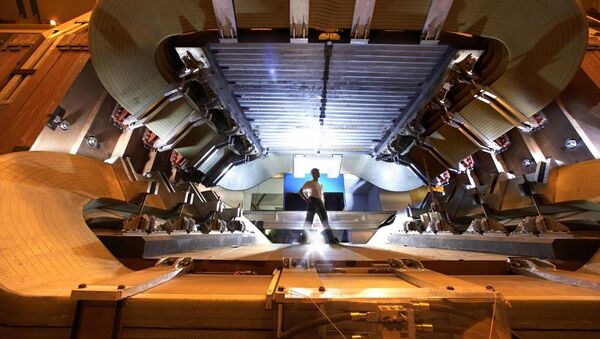Scientists continue efforts to resume the regular operation of the Large Hadron Collider (LHC) following a recent power failure which shut down the device, the European Organization for Nuclear Research (CERN) said on its website.
The failure occurred on Tuesday in an 18 000-volt power line at one of the CERN's sites above the collider's subterranean circuit just a day after the device set a world record as the highest-energy particle accelerator by pushing its twin beams of protons to energy of 1.18 TeV.
The beams of protons started circulating again in both directions around the LHC late on Wednesday as no lasting damage has been made to the device as a whole, the CERN said on its website.
Experiments using the LHC were suspended last September shortly after a successful start, due to a malfunction of two superconducting magnets and a subsequent helium leak into the tunnel housing the device.
Work to repair the collider and upgrade it took over a year. A system to protect it from such accidents, named the Quench Protection System, was installed, and the first beams were injected into the LHC on November 20.
The collider, located 100 meters under the French-Swiss border with a circumference of 27 km, enables scientists to shoot subatomic particles round an accelerator ring at almost the speed of light, channeled by powerful fields produced by superconducting magnets.
In order to fire beams of protons round the vast underground circular device, the entire ring must be cooled by liquid helium to minus 271 degrees C, just two degrees above absolute zero.
By colliding particles in front of immensely powerful detectors, scientists hope to detect the Higgs boson, nicknamed the "God particle," which was hypothesized in the 1960s to explain how particles acquire mass. Discovering the particle could explain how matter appeared in the split-second after the Big Bang.
The international LHC project has involved more than 2,000 physicists from hundreds of universities and laboratories in 34 countries since 1984. Over 700 Russian physicists from 12 research institutes have taken part.
The construction of the collider cost $4.9 billion, while its repairs after the breakdown cost almost $40 mln.
According to CERN, the first physics at the LHC is scheduled for the first quarter of 2010, at collision energy of 7 TeV (3.5 TeV per beam).
MOSCOW, December 3 (RIA Novosti)




